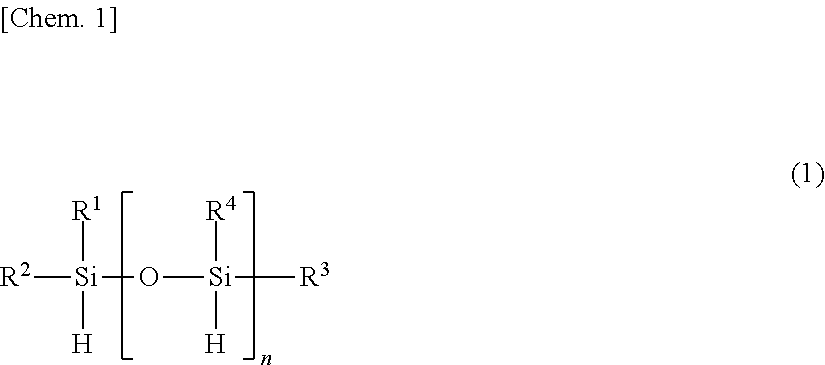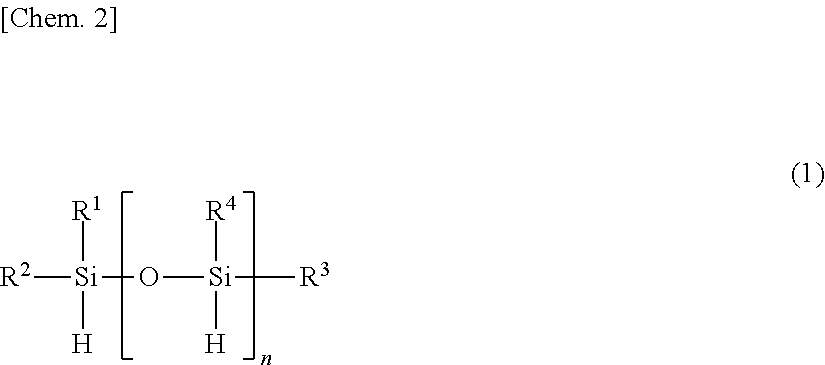Method for producing silanol compound and hydrogen
a technology of silanol compound and hydrogen, which is applied in the direction of sustainable manufacturing/processing, physical/chemical process catalysts, final product manufacturing, etc., can solve the problems of high energy consumption, difficult storage and transportation of hydrogen, and liquefaction of hydrogen at 253° c. , to achieve the effect of high safety and stability, convenient storage and transportation, and convenient storag
- Summary
- Abstract
- Description
- Claims
- Application Information
AI Technical Summary
Benefits of technology
Problems solved by technology
Method used
Image
Examples
preparation example 3
, and
DESCRIPTION OF EMBODIMENTS
[0022]Method for Producing Silanol Compound and Hydrogen
[0023]The method according to the present invention for producing a silanol compound and hydrogen includes subjecting a hydrosilane compound and water to a reaction with each other in the presence of a solid catalyst to give a silanol compound and hydrogen. The solid catalyst includes hydroxyapatite and gold particles supported on the hydroxyapatite, where the gold particles have an average particle size of 2.5 nm or less.
[0024]Solid Catalyst
[0025]The solid catalyst for use in the present invention includes hydroxyapatite and gold particles, where the gold particles have an average particle size of 2.5 nm or less and are supported on the hydroxyapatite.
[0026]The solid catalyst has an average particle size of typically 0.1 to 50 μm, preferably 0.1 to 20 μm, and particularly preferably 0.1 to 0.5 μm, as determined by direct observation using a transmission electron microscope (TEM). The solid cataly...
preparation example 1 (
Solid Catalyst Preparation)
[0077]Glutathione (1.0 mmol) was added to 50 mL of a solution of HAuCl4 (0.25 mmol) in methanol, followed by stirring at 0° C. in an air atmosphere for 30 minutes. Next, the reaction mixture was combined with a solution of KBH4 (1.0 mmol) in methanol, followed by stirring at 0° C. for one hour.
[0078]Precipitates were isolated from the reaction mixture using a centrifuge and redispersed in water to give a dispersion.
[0079]The prepared dispersion was combined with hydroxyapatite (hereinafter also referred to as “HAP”, trade name Tricalcium Phosphate, supplied by Wako Pure Chemical Industries, Ltd.; 10 g), followed by stirring at room temperature for 4 hours.
[0080]The resulting reaction mixture was filtered to give a filter residue (filter cake), and the filter residue was washed with deionized water, dried in a vacuum, further fired at 400° C. in an air atmosphere for 8 hours to remove glutathione deposited on gold particles, and yielded a solid catalyst (1)...
preparation example 2 (
Solid Catalyst Preparation)
[0081]A solid catalyst (2) (Au / HAP, supported Au amount: 2.0 weight percent) was prepared by a procedure similar to that in Preparation Example 1, except for adding HAP in an amount of 2.5 g. Gold particles in the solid catalyst (2) had an average particle size of 2.3 nm, and a standard deviation (σ) in particle size distribution of 0.23 nm.
PUM
| Property | Measurement | Unit |
|---|---|---|
| particle size | aaaaa | aaaaa |
| particle size | aaaaa | aaaaa |
| particle size | aaaaa | aaaaa |
Abstract
Description
Claims
Application Information
 Login to View More
Login to View More - R&D
- Intellectual Property
- Life Sciences
- Materials
- Tech Scout
- Unparalleled Data Quality
- Higher Quality Content
- 60% Fewer Hallucinations
Browse by: Latest US Patents, China's latest patents, Technical Efficacy Thesaurus, Application Domain, Technology Topic, Popular Technical Reports.
© 2025 PatSnap. All rights reserved.Legal|Privacy policy|Modern Slavery Act Transparency Statement|Sitemap|About US| Contact US: help@patsnap.com



